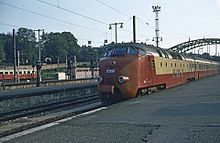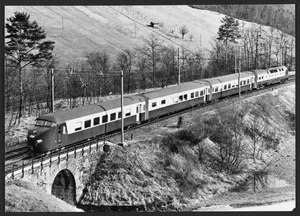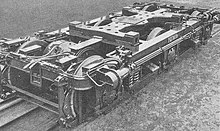SBB RAm TEE / NS DE IV
| SBB RAm / NS DE IV | |
|---|---|
|
A RAm TEE I in action
|
|
| Numbering: | SBB RAm 501–502 NS DE IV 1001–1003 1977 before shipment: ONR 1900–1903 1977 in Canada: ONR 1980–1983 |
| Number: | 5 four-car trains |
| Manufacturer: |
Car: SIG Triebkopf : Werkspoor electrical equipment: BBC |
| Year of construction (s): | 1957 |
| Retirement: |
Sale to Canada: 1977 Retirement: 1992 |
| Axis formula : | (A1A) (A1A) + 2'2 '+ 2'2' + 2'2 ' |
| Gauge : | 1435 mm ( standard gauge ) |
| Length over buffers: | 98,060 mm |
| Height: | 4210 mm |
| Width: | 2840 mm |
| Trunnion Distance: |
Power end: 15,875 mm, wagon: 18,300 mm |
| Bogie axle base: |
Power end: 4500 mm, wagon: 2700 mm |
| Empty mass: | 228.8 t |
| Friction mass: | 76 t |
| Wheel set mass : | 19.1 t |
| Top speed: | 140 km / h |
| Installed capacity: | 1350 kW |
| Driving wheel diameter: | 1040 mm |
| Inner impeller diameter: | 1040 mm |
| Impeller diameter: | 940 mm (trolley) |
| Motor type: | 2 × RUHB 1616 |
| Motor type: | 2 × sixteen-cylinder four-stroke V-engines with Büchi - high-pressure charging and charge-air cooling |
| Power transmission: | electrical generator coupled directly to the diesel engine |
| Tank capacity: | 4500 liters |
| Number of traction motors: | 4th |
| Drive: | Brown Boveri spring drive |
| Transmission ratio: | 23:72 |
| Brake: | Oerlikon |
| Train brake: | Oerlikon compressed air brake with quick brake, block brakes |
| Train control : | Swiss SIFA, Indusi retrofitted in 1971 |
| Seats: | 114 + 32 train restaurant |
| Classes : | 1st class only |
The RAm (also RAm TEE I ) of the Swiss Federal Railways (SBB) and DE IV of the Nederlandse Spoorwegen (NS) were diesel multiple units for the TEE service that were jointly developed and used by both railways.
After being retired by the SBB and NS, the units drove for twenty years in Canada on the Ontario Northland Railway .
history
With the establishment of the Europe-wide TEE long-distance train network, the joint Trans-Europ-Express Commission agreed that diesel multiple units should be used for these services. The French SNCF and the Italian FS developed existing diesel multiple units, the DB put the new VT 11 5 diesel multiple units into service. The SBB and the NS agreed to develop a common design. The concept of a multiple unit was pursued, which provided a powered end car , two intermediate cars , including a half dining car , and a control car . The Swiss determined the type designation RAm for these trains, the Dutch DE IV. Two units (RAm 501 and 502) were employed by the SBB, three (DE 1001 to 1003) by the NS. But all five trains were based in Zurich.
technology
The Dutch company Werkspoor in Utrecht developed the diesel power heads , also known as machine cars , which were provided with the characteristic head shape designed by the interior designer Elsebeth van Blerkom . The intermediate and control cars were built by SIG in Switzerland. Due to their low construction, which was based on the SBB standard cars, they had a typically Swiss appearance, right through to the aluminum double revolving doors of a similar design as in the SBB standard cars . The control cars had the same head shape as the power cars. The power end and wagon were the same height, so that the image of a single, closed train emerged. The electrical equipment for all vehicles came from Brown, Boveri & Cie. The units were equipped with automatic central buffer couplings from Scharfenberg at the ends of the cab and could run in double traction. This option was hardly used later in the company.
The machine cars were equipped with two RUHB 1616 diesel engines from Werkspoor, as they were also installed in the NS three-part Plan U diesel multiple units . The engines were similar to those in the submarines the Navy Koninklijke used. The Buchi with high-pressure turbocharging provided Sixteen-cylinder V-engines with intercooling were with a Ricardo - swirl chamber injection equipped. The cylinder bores had a diameter of 160 mm, the stroke was 200 mm. Each engine could deliver an output of 1000 hp . They drove a direct current generator , which supplied the two traction motors in a bogie , which were constantly connected in parallel, with a maximum voltage of 650 V. A third diesel engine with an output of 300 hp drove a 220/380 V three-phase generator , which supplied the electrical energy for the on-board network of the cars with the air conditioning and the dining car kitchen. The auxiliary systems of the machine car were supplied with energy by 50 kW direct current generators flanged to the main generator. In addition to the two compressors for supplying compressed air to the train, this also included the electric fans for the cooling system of the diesel engines as well as the control power supply, battery charging and emergency lighting. The main diesel engines were started electrically, for which a battery with a capacity of 300 ampere hours with 90 cells was available. The generator served as a starter during the starting process .
Because of the high mass of the power car, the bogies had to be equipped with an additional running axle so that the axle load could be kept below 20 t. The wheel arrangement of the machine car was (A1A) (A1A). The maximum speed was set at 140 km / h. In the powered end there was a workplace for the on-board mechanic, a luggage room, customs and train driver's compartment , as well as a staff toilet. There was an illuminated train route sign behind a small window next to each entrance door. The transitions between the cars were arranged off-center. The compartment windows were designed as double windows with blinds between the window panes, which could be operated with hand cranks. The air conditioning was provided by Stone devices.
The powered end was followed by a car with nine compartments, each with six seats, which offered space for 54 passengers. This car was joined by the restaurant car with a kitchen and 32 seats in the dining room. The galley was equipped with appliances from Swiss manufacturers. There was another 18 seats in an open-plan compartment. The control cars, which offered space for 42 passengers, were also designed as open-plan cars. In this compartment, the seating arrangement was 2 + 1, with all seats arranged in seating groups opposite. The on-board mechanic's rest room was located directly behind the driver's cab of the control vehicle.
The paintwork of the units was shown in the TEE colors purple-red ( RAL 3004) and beige (no RAL color), whereby, in contrast to the DB, no decorative strips were used. At the head ends the red colored area was drawn up at an angle. "TRANS EUROP EXPRESS" was written above the windows of the dining car. The respective operator - SBB-CFF or NS, and the vehicle number were only attached to the power car as small letters.
commitment


The five multiple units were used in a joint five-day route plan, which touched five countries:
- Day 1: Zurich – Basel – Strasbourg – Luxembourg – Brussels – Amsterdam as TEA "Edelweiss"
- Day 2: Amsterdam – Brussels – Paris as TEE “Étoile du Nord” , Paris – Brussels as TEE “L ' Oiseau bleu ”
- Day 3: Brussels – Paris as TEA “L'Oiseau bleu”, Paris – Amsterdam as TEA “Étoile du Nord”
- Day 4: Amsterdam – Zurich as TEA "Edelweiss"
- Day 5: Workshop stay in Zurich.
What was striking about the plan was that the TEE “L'Oiseau bleu” touched neither Dutch nor Swiss territory. If one of the NS / SBB trains failed, an SNCF replacement set with INOX wagons was used. The schedule was valid until 1964, when the trains "Étoile du Nord" and "L'Oiseau bleu" were converted to new locomotive-hauled trains with PBA type stainless steel cars. In addition to the remaining TEE “Edelweiss”, the TEE run “ L'Arbalète ” Zurich – Basel – Mulhouse – Belfort – Paris was introduced, where the sets replaced French RGP multiple units. After “L'Arbalète” was also converted to locomotive-hauled wagons, the TEE Bavaria Zurich – Lindau – Kempten – Munich was set up.
In this relation, one of the largest train accidents in TEE history occurred at Aitrang on the evening of February 9, 1971 , when the RAm 501 derailed as TEE 56 due to excessive speed. 28 people died in this accident, 42 were seriously injured. The high number of dead and injured is also explained by the fact that the windows of the TEE multiple unit were not made of laminated glass and the furniture of the dining car was not firmly anchored. The reason for the excessive speed could not be clarified with certainty; however, it is assumed that there is a defect in the Oerlikon brake system.
The control car and the seated car were dismantled on the spot, the diesel drive head first came to Zurich and was then scrapped in the Netherlands; its bogies stood at the main workshop in Zurich for years. The remaining four RAm units were used until 1974 in the course of the “Edelweiss” TEE and were then parked.
Northlander
In 1976, the remaining four units were sold to Canada to the rail vehicle manufacturer Urban Transportation Development Corporation (UTDC), who leased them to Ontario Northland Railway (ONR). Before being shipped to Canada, the trains were overhauled, rebuilt and repainted in Switzerland by the SBB workshop in Zurich and SIG, in Holland by the NS workshop in Tilburg . The modifications included additional insulation and the installation of new headlights, beacons, number boxes and bells according to Canadian standards. In some cases, new windows were installed and the seat covers replaced.
ONR, which belongs to the province of Ontario , used the trains with the numbers 1980 to 1983 on their 388 kilometer long Toronto - Timmins line . Werkspoor no longer produced spare parts for the engines, so that the maintenance of the trains' end cars was too costly. They were shut down from 1979 and scrapped in North Bay in 1984 .
The remaining three cars of each multiple unit were coupled with an FP7 diesel locomotive built by EMD in the 1950s . The control car was not adapted, as the trains were rotated in the terminal stations so that the locomotive always ran at the Zugspitze. The trains with the numbers 1984 to 1987 ran in this configuration until 1992, the year UTDC was sold to Bombardier .
After the Northlander had been converted to Canadian rolling stock, the Swiss TEE Classics bought eight cars in 1996 , five of which were shipped to Europe in 1998. There were two control cars, a dining car and two seating cars. After processing, they should be used in tourist traffic. After standing in the Port of Hamburg for months because the wheelsets met North American standards with a rear surface spacing that was too small for the European network, they were housed in Germany and Switzerland.
The foundation Stichting Trans Europ Express Nederland acquired the cars in 2006 and on 25/26. June 2006 transferred to Zwolle , where they should be refurbished operationally at Nedtrain . It was planned to use them again after a new power end was manufactured. In 2007, the car began to be painted in red and beige again. However, the project stalled and in 2019 the wagons were still parked in the Amsterdam Dijksgracht marshalling yard, where they were repeatedly damaged by vandals. In December 2019, a new parking space was found near Amsterdam Centraal for the four-car train. The control car and a middle car are painted in red-beige, one middle car is still painted in the Northlander design, but all are no longer in top condition due to the long storage time and damage caused by vandalism.
The three cars left behind by TEE Classic in Canada were two control cars and one dining car. A control car that came from the second SBB train was scrapped in 2002 - it was the last remaining SBB vehicle. The remaining two cars were badly damaged by fire in 2005, but were still there in 2009.
literature
- Franz Gerber: The renewal planning of the SBB's rolling stock: Extract from the lecture . In: Schweizerische Bauzeitung . tape 75 , 1957, doi : 10.5169 / seals-63394 .
- Trans-Europ-Express multiple units . In: Schweizerische Bauzeitung . tape 76 , 1958, doi : 10.5169 / seals-63921 .
- Documentation No. 1 from TEE-CLASSICS - The RAm TEE I multiple units of the Nederlandse Spoorwegen and the Swiss Federal Railways
- Daniel Heer : TEE I ade in: Railway Amateur (magazine) No. 7, 1974, pages 317-321
- Hans-Bernhard Schönborn : The TEE trains in Switzerland. Luxury trains for Europe . GeraMond, Munich 2002, ISBN 3-7654-7122-4
Web links
- Report on work as a Northlander in Ontario ( Memento from October 13, 2012 in the Internet Archive )
- Reports on the return to Europe
- TEE-Classics (Switzerland)
- Stichting TEE (Netherlands)
- Northlander return action series of the SWR series "Eisenbahnromantik"
Individual evidence
- ↑ a b c d e Swiss Construction Journal, 1958
- ↑ Arjan den Boer: TEE Design. Railcars on Trans Europ Express posters. Accessed September 4, 2019 .
- ↑ a b c Swiss construction newspaper. 1957.
- ↑ a b Feijenoordse Meesters. Accessed August 31, 2019 .
- ↑ Afbeeldingen Werkspoor motors. In: Binnenvaarttaal. Association 'De Binnenvaart', Dordrecht, accessed on 31 August 2019 .
- ^ Treinen naar Canada. Stichting Trans Europ Express Nederland, accessed on September 4, 2019 (Dutch).
- ↑ O. Welti: The inconsistent with the Märklin “Northlander” trains . In: Railway amateur . No. 3 , 1979, pp. 160 .
- ^ Brian Hollingsworth, Arthur F. Cook: Das Handbuch der Lokomotiven , Weltbild Verlag, Augsburg 1996, ISBN 3-86047-138-4 , p. 318
- ↑ News in brief . In: Railway amateur . No. 3 , 1980, Canada, pp. 591 .
- ↑ News in brief . In: Railway amateur . No. 3 , 1985, pp. 148–149 (with pictures).
- ^ Bombardier Celebrates 20 Years of Making World-Class Planes and Trains in Ontario - Bombardier. Accessed September 4, 2019 .
- ↑ a b c withered rijtuigen from Stichting TEE Nederland Stichting Trans Europ Express Nederland, accessed on September 4, 2019 (Dutch).
- ↑ Geen goed begin van 2019. Stichting Trans Europ Express Nederland, accessed on September 4, 2019 (Dutch).
- ↑ Laatste nieuws. Stichting Trans Europ Express Nederland, accessed on January 1, 2020 .






